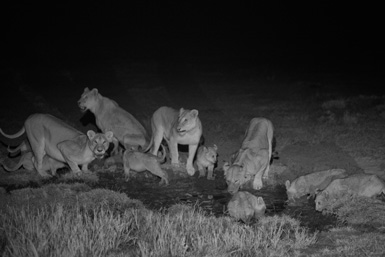Breaking your overall question down you ask:
Would someone with darkvision or Devil's Sight be able to discern those lighting differences we consider important to our normal vision?
Would someone with darkvision or Devil's Sight be able to detect where subtle shadows are when there's a faint light source to cast them?
Do the rules have anything to say, or is there guidance from closely connected material or other editions available?
Darkvision
A discussion of the difference between these the rules describing darkvision can be found here what is the correct interpretation of darkvision and the rest of this answer will assume that darkvision is consistently applied as written in the race descriptions (e.g. dwarf PHB p.20) though it actually does not make much difference to the answers.
Darkvision PHB p.20:
You can see in dim light within 60 feet of you as if it were bright light, and in darkness as if it were dim light. You can’t discern color in darkness, only shades of gray.
There are two specific levels of light covered here:
- Dim light, where there is a source of light
- Darkness, where there is no source of light
In both cases darkvision enhances vision such that "you see as if it were [the next higher level of lighting condition]". Obviously you can also see at all light levels in between using the same "as if" rule and there can be no shadows if there is no light source. As always the light level present are adjudged by the DM.
Addressing your questions one by one:
1. Would someone with darkvision be able to discern those lighting differences we consider important to our normal vision?
Using the "as if" rule YES, with the exception that colour is replaced with shades of grey in darkness. If a creature with normal vision would be able to discern the lighting difference in the "as if" lighting condition, then so can a creature with darkvision in the actual lighting condition. Otherwise they can't.
2. Would someone with darkvision be able to detect where subtle shadows are when there's a faint light source to cast them?
The question appears to be asking "would you be able to see subtle shadows if the lighting conditions were less than dim but more than darkness?"
If the DM adjudges that a creature with normal vision in the "as if" light level would be able to see the subtle shadows in question then YES, a creature with darkvision can see them in the actual lighting conditions. There is obviously no sudden jump between darkvision's benefits in dim light to those in darkness, it is continuous.
Devil's Sight
There is a discussion about how the Warlock ability Devil's Sight works here.
Warlock's Devil's Sight (PHB p108):
You can see normally in darkness, both magical and nonmagical, to a distance of 120 feet.
This lets you see in total darkness as if it were full light. You gain no bonuses in dim light from Devil's Sight so the answer for darkvision above applies. However for full darkness you get "normal" sight. So it is full colour and any enhancements (goggles of minute seeing) also work. However as there is no light source there will be no shadows. Weird.
Addressing your questions one by one:
1. Would someone with Warlock's Devil's Sight be able to discern those lighting differences we consider important to our normal vision?
In dim light no. In total darkness yes, with the caveat that there would be no shadows. Darkvision is a separate ability.
2. Would someone with Warlock's Devil's Sight be able to detect where subtle shadows are when there's a faint light source to cast them?
No, it has no effect in dim light, only in darkness. Darkvision is a separate ability.
A devil's Devil's Sight works differently, however. For instance the Barbed Devil (MM p.70):
Magical darkness doesn't impede the devil's darkvision
So the answers for darkvision above would apply, with the caveat that magical darkness does not impede the darkvision.
Darkvision and Devil's Sight
3. Do the rules have anything to say, or is there guidance from closely connected material or other editions available?
The RAW from the 5e core rule books actually cover the questions you ask. I can find no other guidance specific to your questions in 5e supplementary material. As stated elsewhere, rules from other editions are not a reliable guide.
To list the sources defining darkvision that I have found in the core rule books:
- PHB p.183 Darkvision
- PHB race darkvision descriptions (e.g. p.20 dwarf)
- Monster Manual p.9 "monster" specific darkvision
- PHB p.108 Warlock's Devil's Sight
- Monster Manual p.70 Barbed Devil (and other devils) Devil's Sight
- (Sage Advice on Devil's Sight)[http://www.sageadvice.eu/2015/11/18/devils-sight-vision/]
And there are also rpg stack exchange questions on this, as referenced above:
- what is the correct interpretation of darkvision
- how should a warlock's Devil's Sight work

